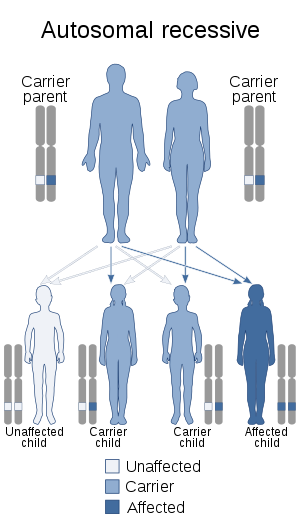De Barsy syndrome
De Barsy syndrome is a rare autosomal recessive genetic disorder. Symptoms include cutis laxa (loose hanging skin) as well as other eye, musculoskeletal, and neurological abnormalities.[2] It is usually progressive, manifesting side effects that can include clouded corneas, cataracts, short stature, dystonia, or progeria (premature aging).[3]
| De Barsy syndrome | |
|---|---|
| Other names | Cutis laxa-corneal clouding-intellectual disability syndrome[1] |
 | |
| De Barsy syndrome is inherited in an autosomal recessive manner. | |
It was first described in 1967 by De Barsy et al. and, as of 2011, there have been 27 cases reported worldwide.[4] The genes that cause De Barsy syndrome have not been identified yet,[3] although several studies have narrowed down the symptoms' cause.[5] A study by Reversade et al. has shown that a mutation in PYCR1, the genetic sequence that codes for mitochondrial enzymes that break down proline, are prevalent in cases of autosomal recessive cutis laxa (ARCL), a condition very similar to De Barsy syndrome.[6] A study by Leao-Teles et al. has shown that De Barsy syndrome may be related to mutations in ATP6V0A2 gene, known as ATP6V0A2-CDG by the new naming system.[5]
Alternative names for De Barsy syndrome include corneal clouding-cutis laxa-mental retardation, cutis laxa-growth deficiency syndrome, De Barsy–Moens–Diercks syndrome, and progeroid syndrome of De Barsy.[2]
References
- RESERVED, INSERM US14-- ALL RIGHTS. "Orphanet: De Barsy syndrome". www.orpha.net. Retrieved 24 October 2019.
- "De Barsy Syndrome". Cigna. Retrieved 2011-08-14.
- Morava, Éva; Guillard, Maïlys; Lefeber, Dirk J; Wevers, Ron A (2009). "Autosomal recessive cutis laxa syndrome revisited". European Journal of Human Genetics. 17 (9): 1099–110. doi:10.1038/ejhg.2009.22. PMC 2986595. PMID 19401719.
- Kivuva, Emma C.; Parker, Michael J.; Cohen, Marta C.; Wagner, Bart E.; Sobey, Glenda (2008). "De Barsy syndrome: A review of the phenotype". Clinical Dysmorphology. 17 (2): 99–107. doi:10.1097/MCD.0b013e3282f4a964. PMID 18388779.
- Leao-Teles, Elisa; Quelhas, Dulce; Vilarinho, Laura; Jaeken, Jaak (2009). "De Barsy syndrome and ATP6V0A2-CDG". European Journal of Human Genetics. 18 (5): 526. doi:10.1038/ejhg.2009.218. PMC 2987315. PMID 20010974.
- Reversade, Bruno; Escande-Beillard, Nathalie; Dimopoulou, Aikaterini; Fischer, Björn; Chng, Serene C; Li, Yun; Shboul, Mohammad; Tham, Puay-Yoke; et al. (2009). "Mutations in PYCR1 cause cutis laxa with progeroid features". Nature Genetics. 41 (9): 1016–21. doi:10.1038/ng.413. PMID 19648921.
External links
| Classification | |
|---|---|
| External resources |